The Ultimate Guide To Food Logging

If you’re looking to get optimal results from your diet, then food logging is hands-down the way to go.
While there are a plethora of diets that can be effective in helping you reach your fitness goals, no rules-based diet (such as Paleo, Whole30, Atkins, etc.) can come close to matching the exactness and precision of flexible dieting with a food log.
But there’s one big problem with the food logging approach…
Accuracy.
People who keep an accurate food log nearly always get consistent and expected results, while those who struggle with their food logs tend to get off track much more frequently.
Now, for some of these people who don’t do well with food logging, the issue lies more with personality compatibility. In other words, the idea of logging their food drives certain types of people crazy because they see it as far too fussy and would prefer not to do any calorie counting at all.
For these types, we usually change strategies and switch to either meal plans or a rules-based diet.
But the majority of those who struggle with food logging don’t struggle for this reason. Instead, they have major issues with getting an accurate sense of their calorie and macronutrient intake because they’re just not very good at logging.
Let’s take a look at an example…
How Bob Logs A Cheeseburger
Bob is just a regular guy who wants to lose some weight and put on muscle. He’s following a flexible dieting plan put together by his online personal trainer. Bob goes to the diner and orders a big, juicy cheeseburger. The cheeseburger looks like this:
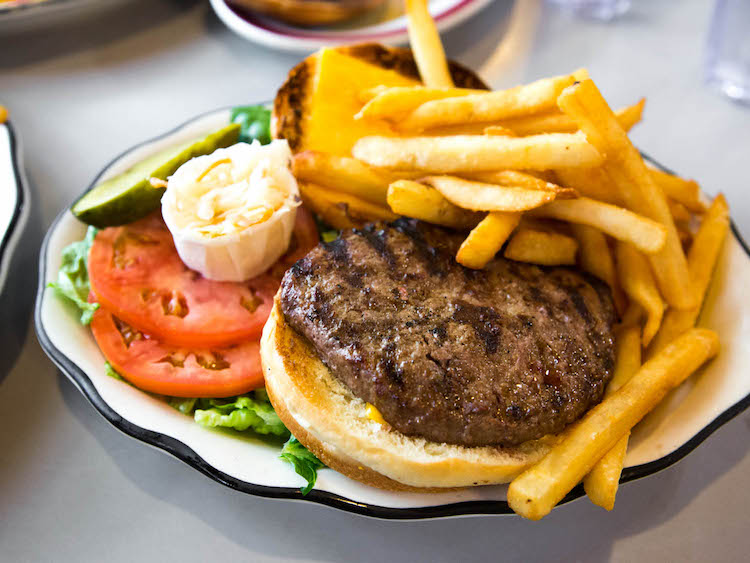
He opens up Cronometer, a food logging app, on his iPhone to log the burger. Bob searches for “cheeseburger” and here’s the first thing that comes up:
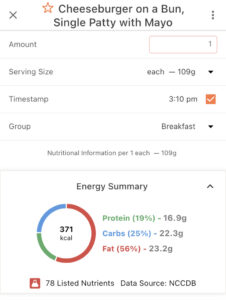
Not only is this the very first item that shows up when Bob searches for “cheeseburger”, so Bob is confident in his choice and adds it to his food journal.
The big problem here?
The cheeseburger that Bob logged as 370 calories is actually more likely to be in the realm of 800-1200 calories.
Which means that Bob actually ate 500-900 additional calories that are unaccounted for in his food journal.
Now let’s say Bob’s calorie target is around 2000 calories per day. Due to inaccurate food logging, even though Bob thinks he’s eating 2000 calories, he’s actually regularly consuming nearly 3000 calories per day. Instead of losing weight, he’ll actually be gaining weight because he’s eating more than he should be.
We still stand by our assertion that food logging is the optimal way to transform your body whether you want to cut, bulk, or recomp. But for food logging to be effective, you have to make an effort to be as accurate as possible with your logs.
And we’re going to help you do just that.
Today we’re sharing with you everything we’ve learned over the years to not only keep a food log that’s as accurate as possible, but also to do so without spending too much time or energy on it.
Food Logging Basics
Now it’s time to get into the actual process of food logging itself. There are 3 primary ways to log the food you eat: fixed serving size, weight, and volume. Let’s take a look at these methods and see when it is appropriate to use each one.
Fixed Serving Size
This is what you would use when eating something that’s prepackaged and has a clear-cut nutrition label. For example, two slices of Pepperidge Farm wheat bread, a packet of instant oatmeal, or a pack of Skittles. This is also the best option for logging food at restaurants and fast food places that have nutrition information based on the dish.
Note that you should use this method ONLY for foods where the serving size is always exactly the same every time you eat it.
A pack of Skittles is always going to match the nutrition information on the label. On the other hand, if you’re eating fresh bagels from a bakery, the size can vary significantly and you want to make sure to use an alternative measurement.
Here’s an example of choosing a fixed serving size in Cronometer:
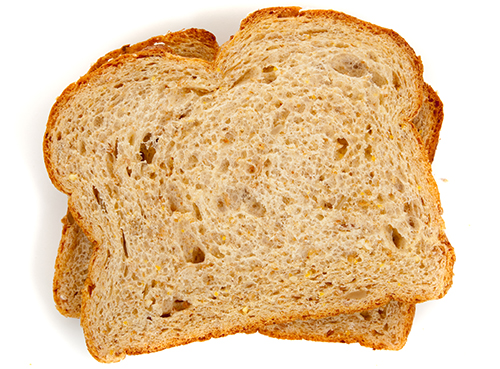
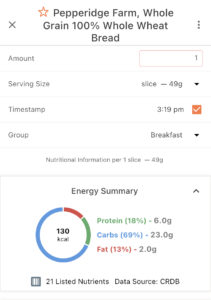
Weight
If you’re eating a food without a fixed serving size, then the next best option is to break out the food scale and weigh it in ounces or grams. Weighing your food on a scale is typically the most accurate way to log most foods, even for foods that you may think it’s better to measure in terms of volume like cereal and peanut butter.
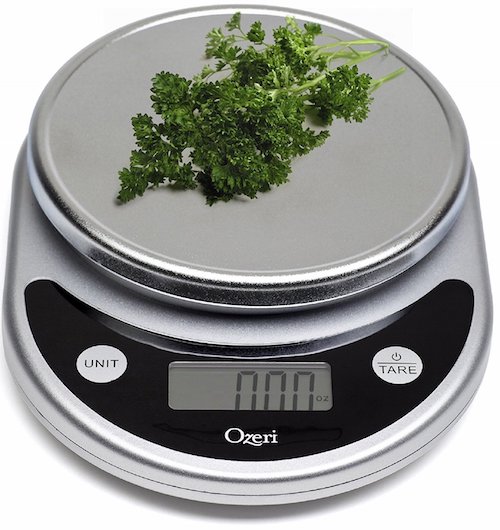
Weighing your food requires you to have access to a food scale which can be cheaply purchased at Amazon. We like the Ozeri Pronto food scale (pictured above) which is less than $12 on Amazon.
Here’s an example of how to log strawberries based on weight:
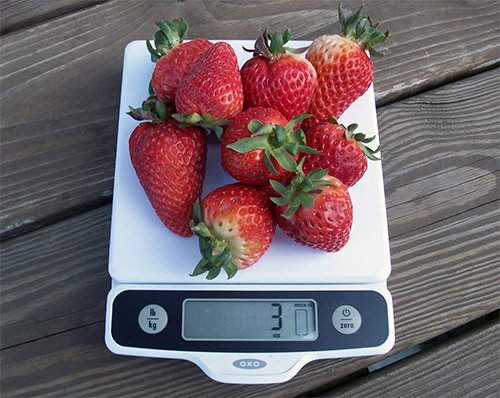
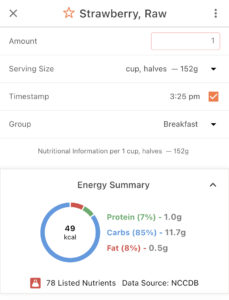
You should also know that almost every nutrition label includes the weight equivalent of its serving size. So if you’re eating potato chips and the serving size is 17 chips, you’ll see from the label that 17 chips will equal approximately 28 grams:
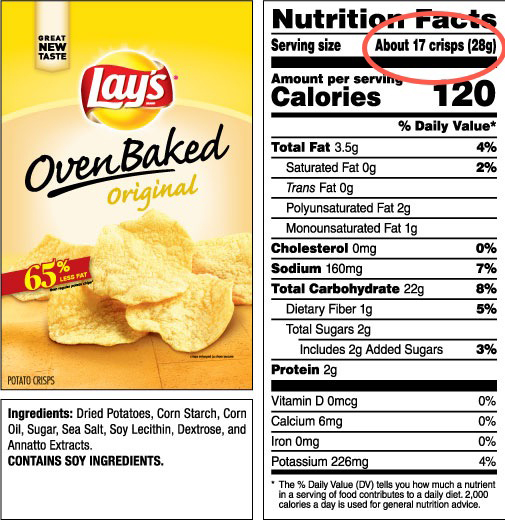
Volume
Measuring your food in terms of volume means measuring your food in tablespoons, cups, fluid ounces, etc. This is the best option when measuring liquids and sauces, and is also useful for eyeballing food when you’re not at home and don’t have access to a food scale.
Otherwise, the volume method is generally the least preferred method of all 3. That’s because it’s far too easy to scoop out a giant heap of Nutella or peanut butter and claim that it’s only a tablespoon. Unless it’s a liquid or a sauce, stick to weighing out your food if you have access to a food scale.
Here’s an example of logging 1 cup of milk based on volume:

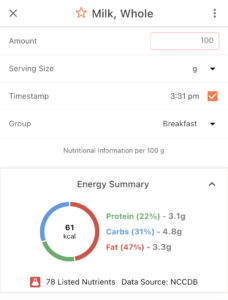
Now that we’ve reviewed the three primary methods used for food logging, let’s take a look at the best approach in various situations. You’re not exactly going to pull out a food scale in the middle of a work lunch or at a restaurant, so your strategy will have to shift depending on the circumstance.
Food Logging At Home
Being at home is clearly the most conducive environment for accurate food logging. You can weigh out each of your meals in a judgment-free zone without the fear of being embarrassed about your diet.
When you’re home, there are generally only two scenarios: you or someone else is cooking or preparing a meal for you, or you’re eating take-out / delivery food from a restaurant.
Cooking
If you’re the one doing the cooking, then logging your food is as easy as logging each of the ingredients in the meal and dividing them by total servings. If you’re using Cronometer, you can simply tap ‘Create Recipe’ and either import the ingredients from a URL or enter them manually.
For example, here are the recipe ingredients for Buffalo chicken with sweet potato fries:
- 1 tablespoon of vegetable oil
- 1 tablespoon of extra virgin olive oil
- 1 pound of boneless skinless chicken breast
- 2 large sweet potatoes (weighing 700 grams in total)
This recipe makes two servings, so I divide each ingredient by 2 and log the meal like this:
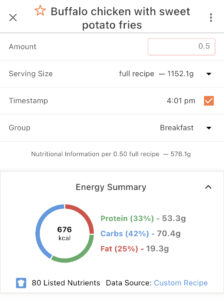
If someone else is doing the cooking for you, you can ask him or her to give you the ingredient list so you can calculate it yourself.
And if this is a meal you eat frequently, you can find it under ‘My Recipes’ in Cronometer and enter it easily in the future. While the first time you enter a recipe may take a few minutes to enter each ingredient, saving the meal makes entering it in the future a breeze.
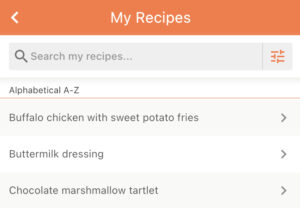
As a general rule, the more you can incorporate home-cooked foods into your diet, the more accurate your food log will be, and therefore your results will be better. It’s much easier to incorporate delicious, high-protein meals into a balanced diet when you’re controlling exactly what’s going into your meals.
Take-Out / Delivery
If you’re eating restaurant food at home, then the food scale is going to be your best friend. No matter what you’re eating, you basically want to weigh out the components of each meal and record them individually. This will help you get the most accurate nutrition for whatever you’re eating.
Keep in mind that it’s never going to be as accurate as logging cooked food because you can’t be sure of all the individual ingredients, how much oil is used, etc., but weighing out your food is by far the best option in this scenario.
Here’s an example of a dinner I regularly order from a local Italian restaurant:

And this is how I log it:
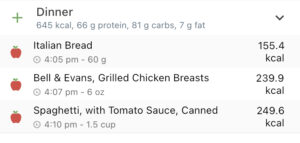
All I did was weigh out the pasta, chicken, and bread, and log each of those foods in my journal. Because this is a frequently eaten meal for me, I save it in Cronometer so I can add it to my logs with a simple click.
The biggest challenge when logging food from restaurants occurs when you order cuisines that you may not know how to find in the food database, such as Chinese, Indian, Thai, etc. For more information on how to log foods like these, see the later section in this guide called “Food Logging Examples”.
Food Logging On The Go
Figuring out how to log your food when you’re on the go can be a big challenge for many people, but certainly not one that’s insurmountable.
For most people, the meal you have on the go is going to be lunch. If you prepare your own lunch at home, then this part is easy; you simply weigh out the ingredients or the individual components of the dish when you’re home and use that information in your logs.
But what if you have a favorite spot where you like to pick up your lunch each day? Or you rotate through 4-5 local restaurants every week?
In these cases, if there’s a lunch you frequently eat but don’t have access to a scale to weigh out the individual portions of food, you have two options:
Visual Estimation
Use rough estimations and enter your food based on the guidelines in the next section, “Food Logging At Restaurants”.
The “Double Lunch” Method
Figure out what’s in your most frequently eaten lunches, weigh them out ONCE and save to your Favorite Meals in the app, and then use the saved meal each time you eat that lunch.
To figure out what’s in these lunches, you can either bring a food scale with you and try to weight out each component without anybody noticing, OR you can do this simple trick…
If you’re going out for one of your favorite lunches, order TWO servings of whatever you normally get. Put one of these lunches in the fridge for you to take home. Weigh out each component of the dish when you get home, log it in your food journal, and then bring that second lunch to work the next day. This way you can figure out the nutrition info for each of your favorite lunches without bringing a food scale to work, and without wasting food.
Food Logging At Restaurants
When you’re eating out at a restaurant, or eating any meal in a situation where you don’t have access to nutrition information or a food scale, then you’re going to need to work on your serving size estimation skills.
Even though eyeballing serving sizes is clearly going to be the least accurate way to enter meals into your food log, it’s extremely helpful for those of us who tend to eat out a lot and want to get as close an estimate as possible for whatever we’re eating.
If you’re eating protein-centric meals where protein is the main ingredient, then the first thing you need to do is estimate the weight of the protein on the plate, whether it is chicken, beef, or fish. A good rule of thumb for this is:
3 ounces of meat, fish, or poultry = 1 deck of cards
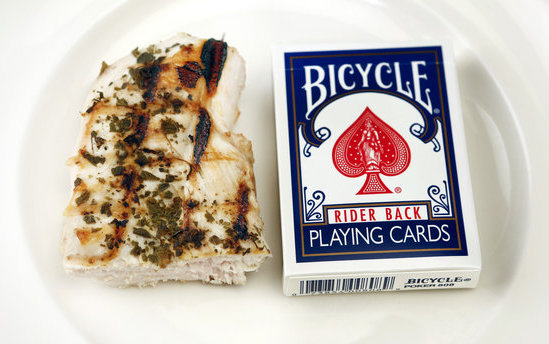
We’ve been using this basic guideline for years and it generally holds up. It will never be perfect, of course, but we’re not looking for perfect in this case – just as close as you can get to a reasonable estimate of the food you eat.
Sometimes restaurants will list the weight of the piece of meat you’re ordering, like a 1/2 pound burger, 12 ounce ribeye steak, etc. In this case, just enter that amount into your food logs, being sure to log the raw version of whatever meat you’re selecting. Whenever a restaurant lists the weight of a burger, steak, lobster, etc, it always uses the pre-cooked weight.
You can get better at estimating meat weights by practicing at home when you have access to a food scale. Whenever you’re weighing meat on your food scale at home, take a second to guess what weight it is using the deck of cards rule listed above. You’ll find that this is a skill that improves with practice.
The next step is to estimate your sides. While it’s easy to estimate the weight of protein using the deck of cards rule, there’s no such rule for weighing other foods because there’s too much variation.
That’s why the key here is to estimate your sides in terms of volume, and more specifically in terms of cups or tablespoons, using the following two guidelines:
1 cup = 1 baseball
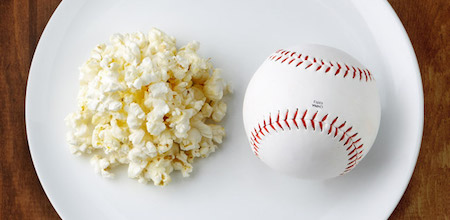
2 tablespoons = 1 golf ball
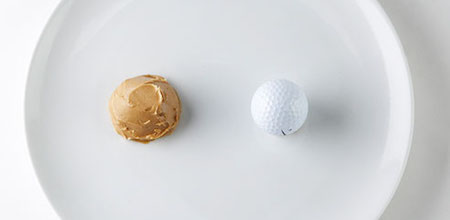
So if you’re having a side of rice, mashed potatoes, pasta, etc., try to estimate how many cups it is by estimating how many “baseballs” it looks like.
Let’s put it all together by showing you how to log a typical dish you might order at a restaurant. Say you go to an Italian restaurant and order the chicken marsala:
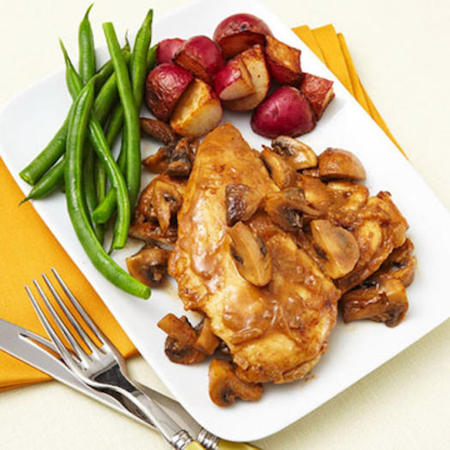
Here’s how we would log this meal in an app:
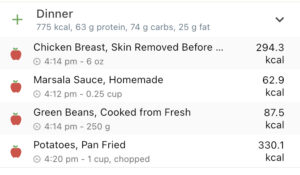
Even though there’s likely more than 6 ounces of chicken on this plate (2 decks of cards), we would choose to only eat “2 decks of cards” worth of chicken to limit the number of calories in the meal. If we ate the full thing, we’d likely log closer to 9 ounces of chicken (3 decks of cards).
As for the sides, it looks like there is a “baseball” of roasted potatoes and a “baseball” of string beans, so that’s why we logged 1 cup of each.
Food Logging Examples
In this section we’re going to show you how we would personally log a bunch of different food items. We’ve found that the best way to teach accurate food logging is through lots of examples.
Cheeseburger
Remember at the beginning of this post when we showed you how Bob logs a cheeseburger? Well let’s take a look at that example again and now we’ll show you how we’d personally log that same cheeseburger.
Here’s the image of the burger once again:

And here’s how we would log it:
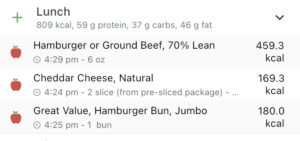
The basic strategy here is just breaking down the burger into its components and logging each ingredient separately. There were about “2 decks of cards” worth of cooked ground beef, 2 slices of cheese, and a large burger bun. As you can see, our original estimate was pretty accurate as this burger is around 800-900 calories.
Pizza
Pizza is an extremely calorie-dense food if you’re logging it by the slice, we can guarantee that you’re underestimating just how many calories you’re consuming.
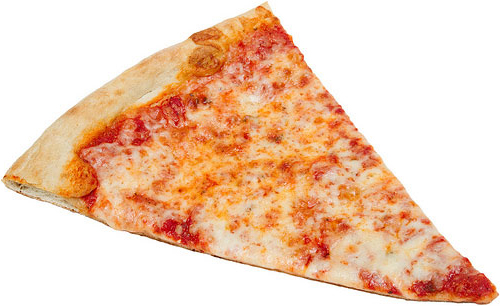
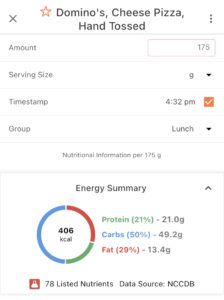
Note that this slice of pizza is 175 grams and 406 calories. If you were to log this via the fixed serving size method – 1 slice of pizza – it says that the slice is only 207 calories.
This is why the fixed serving size method isn’t appropriate for many foods, and why it’s so important to weigh out your food whenever you can.
Peanut Butter and Jelly Sandwich
We’re including a peanut butter and jelly sandwich in this list because we cannot tell you how many times we’ve seen homemade PB&Js, with heaps of peanut butter and jelly, and then entered into an app showing up as only 300 calories (when in fact there’s likely 300 calories in the peanut butter alone).
Peanut butter is one of those foods that is MUCH better to weigh out than use tablespoon measurements for. Prepare to be disappointed, because two tablespoons of peanut butter at 180 calories is probably a lot less peanut butter than you thought.

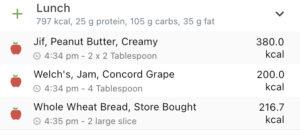
Chinese Food – Spicy Diced Chicken, Beef With Broccoli, and Pork Fried Dumplings
Logging non-American cuisines is always a little trickier because there aren’t many “official” entries for these types of foods in food logging apps.
The key here is to find something that’s close enough to the dish you’re eating and log it in terms of weight.
One of my most frequently ordered delivery meals is spicy diced chicken, beef with broccoli, and steamed pork dumplings from a local Chinese restaurant.
Putting it all together, and adding white rice to the meal, here’s how the dinner looks in terms of nutrition:
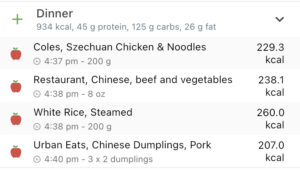
Once you choose the food entry that seems most compatible with what you like to order, you can use those same entries every time you eat that food in the future.
So although it may take a few minutes to find the most appropriate foods, in the future this meal will take literally just seconds to log.
Chocolate Cake
Desserts are often super dense with calories, which makes it extremely important to, yup you guessed it, WEIGH them. We’ve seen people take practically 1/4 of an entire cake and try to get away with logging it as just a slice.
Cakes, cookies, brownies, ice cream, pie…
If you are in a situation where you can weigh them, do it. This will also give you valuable insight into smart portion sizes. You learn that you can easily manage to fit a slice of cake or some cookies into your diet as long as you limit the amount.
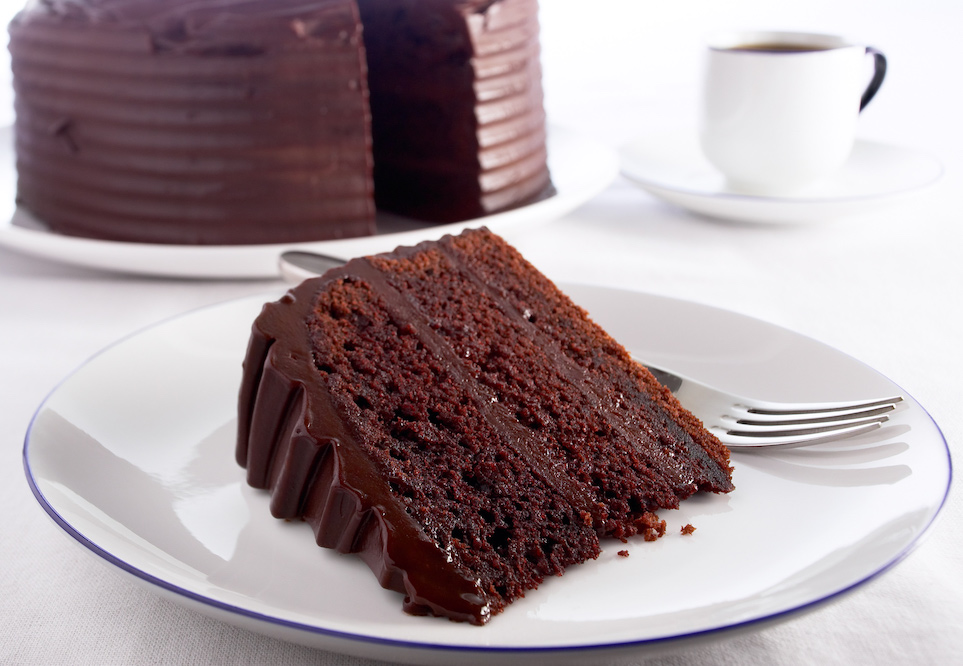
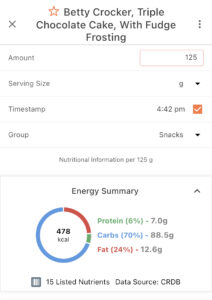
Don’t Aim For Perfection. Aim For Consistency.
As a final note, we want to stress the point that you do NOT have to perfect with your food log, and obsessing about whether or not you ate 5 or 6 ounces of chicken is totally unnecessary. Accept the fact that your food log is only ever going to be an estimation of what you eat.
Rather, focus on consistency. As long as you follow the same general methods outlined in this guide, and continue to choose the same food entries in the database for whatever you eat regularly, then you will see success with the food logging approach.
Frequently Asked Questions
Do I log chicken (or any meat) before or after cooking it?
Anytime you’re cooking, you always want to use the weight of the raw chicken (or any meat) BEFORE you cook it, and then make sure to select the appropriate entry for raw meat from the food database.
Most raw chicken that you purchase from a grocery store will come in a package with the weight and nutrition information right on it, like so:

This label shows that 4 ounces of raw chicken breast is 120 calories with 26 grams of protein. The easiest way to log this chicken is to find this brand or an equivalent item in the food database and use that. Note that pretty much all raw chicken breast is 120 calories per 4 ounces, so it doesn’t really matter which brand you pick.
How do I count vegetable or olive oil that I use when cooking?
For cooking oils, you want to measure out how many teaspoons or tablespoons you’re using in the cooking process and then enter that amount into your food log. For example, if you’re sautéing chicken cutlets using a tablespoon of olive oil, and you’ll be eating half the dish, then you would log 1/2 tablespoon of olive oil in your journal.